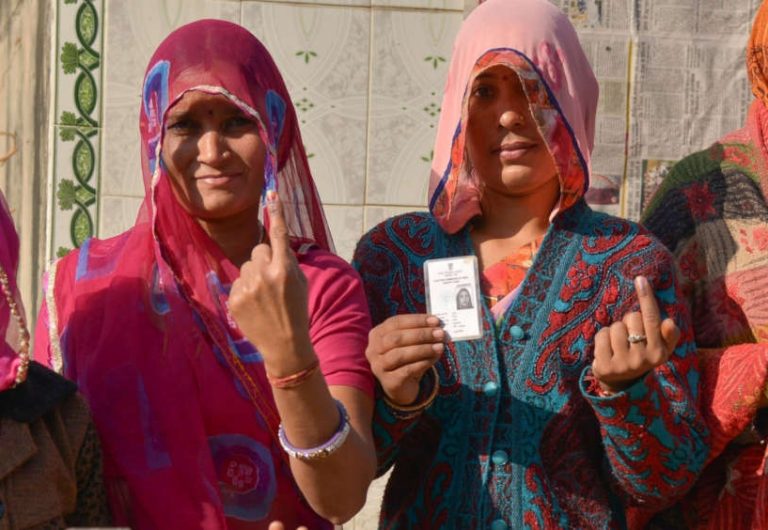
Together, Rajasthan, Madhya Pradesh (MP), Chhattisgarh, Telangana and Mizoram are home to 93 million women. Among the MLAs these states have voted in, only 9% are women, down from 11% from the previous 2013-14 assembly elections, when female candidates had won 77 of 678 seats.
Only in one state, Chhattisgarh, has there been an increase in the proportion of female MLAs, even though more female candidates contested elections across all five states than the last time.
Mizoram will continue to have zero female representation in its state assembly. Women comprise 49% of the state’s population of 1 million-plus population.
“Women might be coming out in higher numbers to vote but in order for democracy to be truly representative, more women MLAs and MPs need to have a seat at the table,” said Rithika Kumar, a researcher at the University of Pennsylvania in the US. “We have seen at the panchayat and municipal level that women are not only capable of winning elections but also getting re-elected.”
In fact, female representatives are more likely to provide public goods that take into considerations women’s needs, Kumar said. “It’s simple—women need to have an equal say in matters that affect them, the economy and society at large,” said Kumar. “It’s time for all big parties to step up and walk the talk and give more tickets to women.”
How the states voted
Although more women have been contesting elections across the five states over the last three elections, they have not been winning in greater numbers–women’s representation at the assembly level has failed to match the increment in the number of candidates.
Madhya Pradesh saw the highest number of female candidates this year–235 of the total 2,716 contestants–higher than the 108 in 2013 and 226 in 2008. However, its number of successful women candidates is at its lowest, at just 22–down from 30 in 2013 and 25 in 2008.
In Rajasthan, 182 female candidates contested out of 2,291 (8%) in 2018, up from 152 of 2,030 in 2013 (7%) and 154 out of 2,194 (7%) in 2008. In 2008, 28 women won the elections to become MLAs and in 2013 the number was 25, but this year it has fallen to 23. In 10 years from 2008 to 2018, the proportion of female candidates has fallen from 14% to 11.5%.
Nevertheless, the proportion of female winners was higher than that of female contestants–women comprised 11.5% of the winners in Rajasthan, even though women contestants comprised only 8% of all contestants. Similarly, 9% of contestants in MP were women, and 10% of winners; 10% of contestants in Chhattisgarh were women, and 14% of winners.

Source: Association for Democratic Reforms (ADR), State Assembly Reports 2018-2008, MyNeta.info
Note: Figures used for number of contestants refer to the number analysed by ADR and may not reflect the total number of contestants in all cases. *Telangana voted for its first assembly in 2014, ahead of separation.
Chhattisgarh is the only state where more women contested as well as won over previous years–13 (14%) of its 90 available seats were won by women candidates, up from 10 (11%) in 2013 and 11 (12%) in 2008.
At 13, the state’s legislative assembly will have its highest number of women representatives over the past three elections.
Mizoram did not elect a single woman, though its number of female candidates has been rising year-on-year. In 2018, 18 female candidates contested state elections, 200% and 100% higher than in 2013 and 2008, respectively.
Party-wise breakdown
Both the Congress and the BJP fielded no more than 12% women candidates, as per National Election Watch, an umbrella organisation of NGOs working for electoral reforms and improving governance. In absolute numbers, the BJP fielded more, 80, the highest number among all parties, while the Congress fielded 70.
An estimated 79 female candidates contested independently of any party affiliation, 40 under the Bahujan Samaj Party (BSP) and 303 under various regional parties.
The Telangana Rashtra Samithi (TRS), the winner in Telangana, gave tickets to the lowest proportion of female candidates, at 3%. The BSP, led nationally by a woman, Mayawati (who goes by one name), had 9% female candidates.

Source: National Election Watch by Association for Democratic Reforms
Note: Figures used for number of contestants refer to the number analysed by ADR and may not reflect the total number of contestants in all cases.
Among the winners, the maximum number of female candidates belong to the Congress, which will have 33 women MLAs across the five states.
It is followed by the BJP with 21 female MLAs. The TRS has elected three women MLAs, the BSP will have two and the Janata Congress Chhattisgarh Jogi and the Rashtriya Loktantrik Party one each.
One female candidate won as an independent.

Source: National Election Watch by Association for Democratic Reforms and Electoral Commission
Note: Figures used for number of contestants refer to the number analysed by ADR and may not reflect the total number of contestants in all cases.
In the last state assembly elections, the BJP had the most female MLAs, and its number of women MLAs has more than halved–from 50 in 2013 to 21 in 2018.
The TRS similarly has half the number of female MLAs–from six in 2014 to three in 2018.
(Sanghera is a writer and researcher with IndiaSpend.)
Courtesy: India Spend
We welcome feedback. Please write to respond@indiaspend.org. We reserve the right to edit responses for language and grammar.
